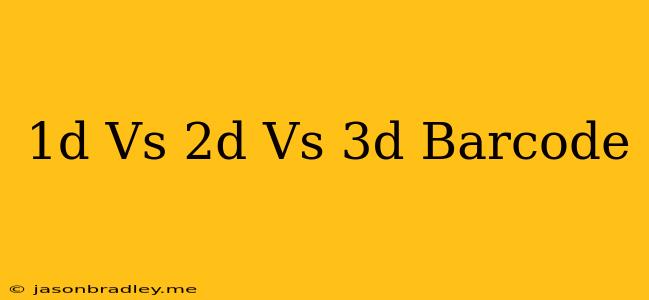Tentu, berikut adalah artikel tentang 1D, 2D, dan 3D barcode:
1D vs 2D vs 3D Barcodes: Which is Right for You?
Barcodes are ubiquitous in today's world, used for everything from tracking inventory to storing product information. But with so many different types of barcodes available, it can be tough to know which one is right for your needs. This article will explore the differences between 1D, 2D, and 3D barcodes, highlighting their unique benefits and drawbacks.
1D Barcodes
1D barcodes, also known as linear barcodes, are the most common type of barcode. They consist of a series of vertical lines of varying widths, representing data in a linear format. Common examples include UPC (Universal Product Code) and EAN (European Article Number) barcodes found on most consumer products.
Advantages:
- Simple and inexpensive to create and read: 1D barcodes can be easily generated and scanned using inexpensive barcode scanners.
- Widely supported: 1D barcodes are supported by almost all barcode scanners and software applications.
Disadvantages:
- Limited data capacity: 1D barcodes can only store a small amount of data, typically up to 20 characters.
- Susceptible to damage: 1D barcodes are easily damaged if the lines are scratched or obscured.
- Difficult to read in low-light conditions: 1D barcodes rely on the contrast between black and white lines, making them difficult to read in low-light conditions.
2D Barcodes
2D barcodes, also known as matrix barcodes, store information in a two-dimensional format using a pattern of squares or dots. Some of the most popular 2D barcode types include QR codes, Data Matrix, and PDF417.
Advantages:
- High data capacity: 2D barcodes can store significantly more data than 1D barcodes, up to thousands of characters.
- More resistant to damage: 2D barcodes are more resistant to damage because they have redundancy built into the pattern.
- Can be read from any angle: 2D barcodes can be read from any angle, making them more user-friendly.
Disadvantages:
- More expensive to create and read: 2D barcode creation and scanning often requires specialized software and hardware.
- Not as widely supported: While gaining traction, 2D barcodes may not be supported by all barcode scanners and software applications.
3D Barcodes
3D barcodes are relatively new and utilize a three-dimensional structure to store information. They are still in their early stages of development and not yet widely used.
Advantages:
- Extremely high data capacity: 3D barcodes can store significantly more data than 2D barcodes, potentially holding millions of characters.
- Highly resistant to damage: 3D barcodes are designed to be extremely robust and resistant to damage.
Disadvantages:
- Expensive to create and read: 3D barcode creation and scanning require advanced technology and are currently very expensive.
- Limited compatibility: 3D barcode technology is still in its infancy and may not be supported by many existing scanners.
Conclusion
The best type of barcode for your needs will depend on a variety of factors, including the amount of data you need to store, your budget, and the required level of security and reliability.
- For simple applications with limited data needs, 1D barcodes are a cost-effective solution.
- For applications requiring more data storage and higher resistance to damage, 2D barcodes are a good option.
- 3D barcodes may be suitable for highly specialized applications demanding extreme data capacity and durability, but their high cost and limited compatibility currently restrict their widespread use.
